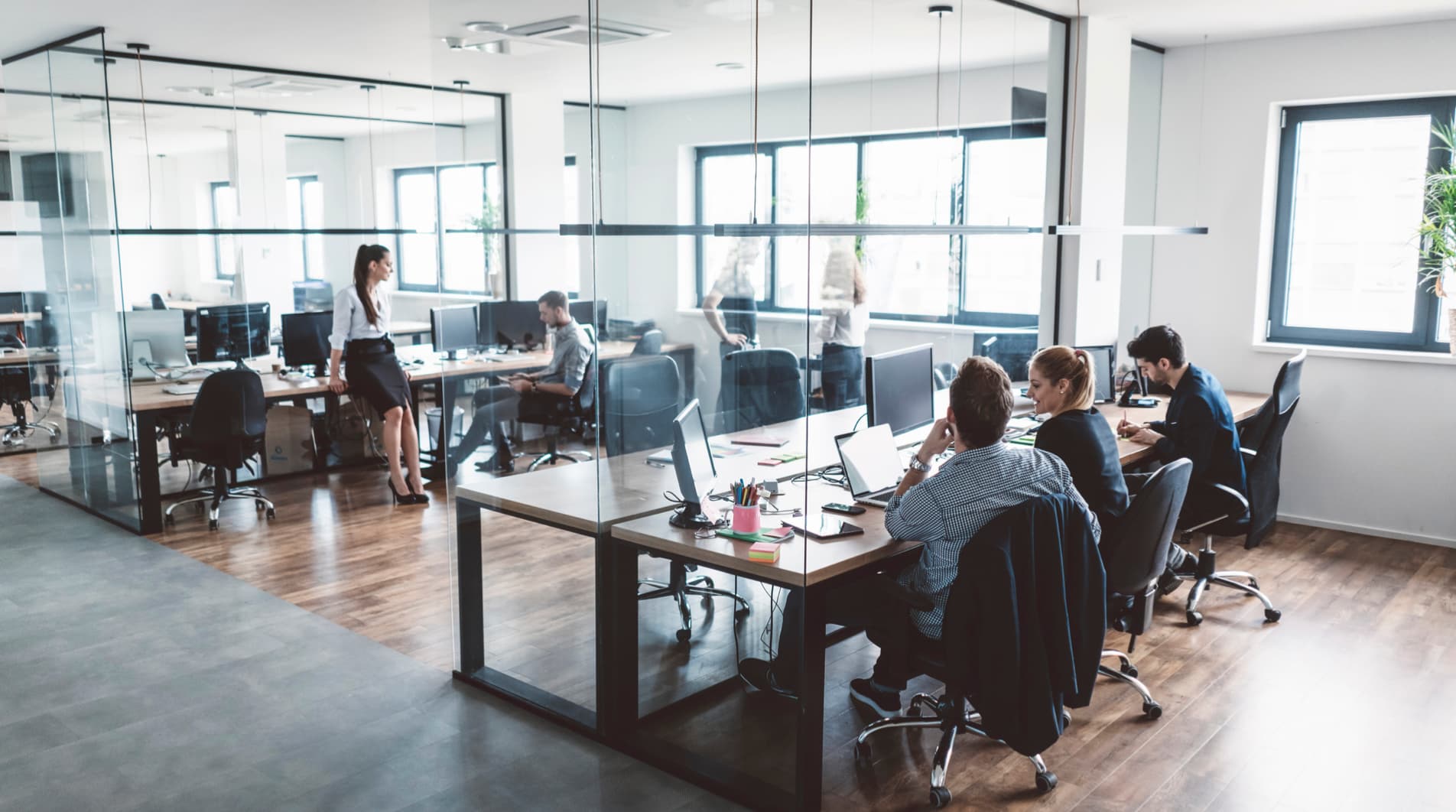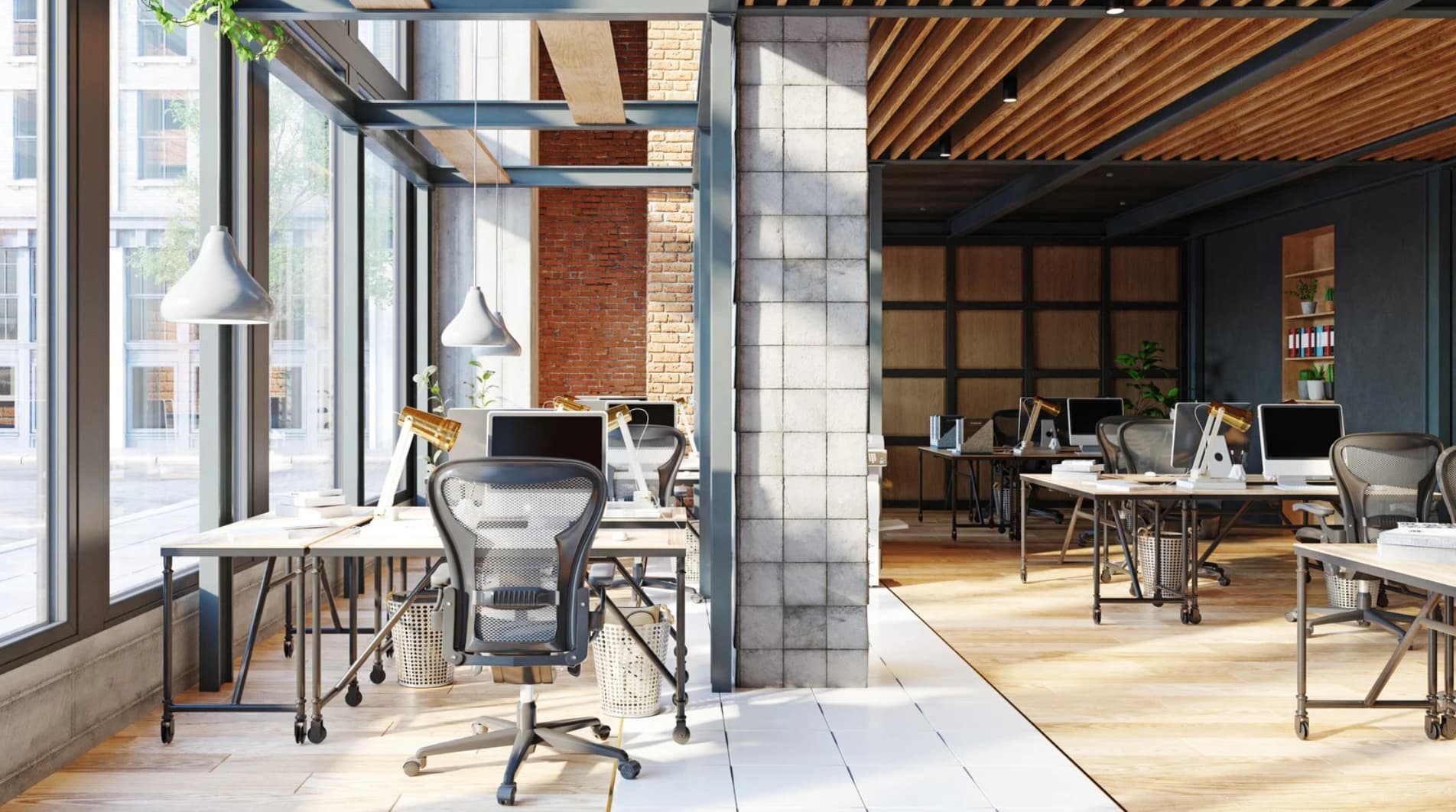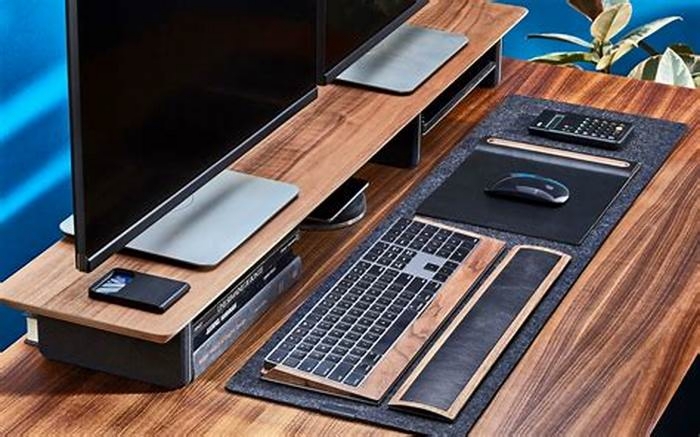Optimizing Your Workspace Layout for Increased Productivity Utilizing Ergonomic Furniture and Tech Gear

Whether you're setting up a new office or refurbishing an existing one, the design and layout of your workspace can significantly affect productivity. In this guide, we'll explore six different types of office layouts and explain how to leverage them for efficiency.
Whether you're planning an office makeover or simply looking to improve workplace performance - dive in! You will find valuable insights, practical examples, and tips to boost productivity here.
TL;DR:
- Office layout significantly impacts productivity and employee satisfaction.
- Six main types of office layouts: Traditional, Team-Based, Open-Plan, Activity-Based, Co-Working, and Home Office.
- Factors to consider when choosing a layout: office size, number of employees, work type, privacy requirements, and budget.
- Tips for designing an efficient office layout: plan space strategically, create a practical floor plan, maximize natural light, use modular furniture, and include ergonomic elements.
- Common mistakes to avoid: neglecting employee needs, inaccurate measurements, lack of storage solutions, and ignoring accessibility requirements.
- Best practices for maintaining an efficient layout: regularly review space utilization, promote cleanliness and organization, encourage movement, and provide quiet zones.
- A well-designed office layout can enhance productivity, employee well-being, and job satisfaction.
What Is an Office Layout?
Essentially, an office layout denotes how the workspace is structured where furniture pieces are placed; how individual desks, meeting rooms, or breakout areas are organized; what kind of decor adorns the space; everything within those four walls composing your work environment falls under this umbrella term.
Our working environment significantly influences our state of mind fundamentally shaping creativity levels, focus abilities, and even interpersonal relationships at work. However unassuming it may seem at first glance, the choice between different office layouts can echo deep into employee satisfaction rates and, ultimately, the entire company's growth pace.

Key Objectives and Benefits of Effective Office Layouts
Workforce performance has a strong correlation with how workplaces are designed. The more thought you've given to creating the best office layout for productivity, the better its impact on your enterprise's bottom line will be. Moreover, an effective office layout also improves employee morale, promotes collaboration, and ensures optimum space utilization.
Taking that under consideration, let's delve deeper into these benefits:
Increasing Productivity Through Design
A well-thought-out office design can enhance morale and notably boost productivity we're referring to what's known as 'office layout productivity.' How does this work? Consider a simple example: if employees waste less time walking from one desk to another or searching for necessary equipment or resources, they naturally do more work during their shift.
Cultivating Collaboration and Communication
An essential aspect of any successful business is clear communication and seamless collaboration between its team members. A strategic approach to designing your workspace can facilitate both.
For instance, providing breakout areas or meeting rooms where cross-functional teams can congregate sparks off innovative ideas. Integrated technology in these spaces ensures smoother information exchange, fostering enhanced communication across hierarchies.
Moving away from isolated cubicles towards open-plan layouts encourages spontaneous conversations and impromptu brainstorms fostering stronger relationships among colleagues and promoting idea sharing.
Supporting Employee Well-being and Satisfaction
It may surprise some people that thoughtful architectural planning dramatically affects staff wellness levels at the workplace. Natural light access reduces strain on the eyes, besides being known to lift mood levels. Optimally acclimatized workspaces with proper office amenities can make workers feel comfortable, minimizing the chances of illnesses.
In addition, providing spaces for employees to relax and rejuvenate such as a quiet reading nook or an inspiring green corner contributes to their mental well-being. Happy and healthy employees are often more productive; hence, this approach strategically benefits the employee while favoring the business's outcome.
Maximizing Space Utilization
Planning your office layout effectively isn't just about influencing productivity and promoting well-being. It is also essential in terms of maximizing space utilization.
Every square meter costs money, so ensure you use each inch effectively. Achieving the right balance between workstations, meeting areas, storage spaces, and relaxation corners could be challenging, but it's integral to match up to optimized operational needs. Remember again - it's not about increasing real estate; instead, it focuses on utilizing existing ones better.
From shared multi-functional desks that can convert into meeting rooms if required to innovative wall storage solutions for files and stationary every minor tweak aimed at efficient space management directs towards cost savings and symbolically mirrors an organized and systematic work culture.
To sum up, a thoughtful investment of time and resources in planning a practical office layout can make a radical difference to your organizational performance fueling productivity, enabling collaboration, and enhancing employee wellness & satisfaction- all under strategic space optimization.
Types of Office Layouts
As we explore the most common modern office layouts, we must understand that no one size fits all. Depending on a combination of factors such as work type, number of employees, and available floor space, an ideal office layout design can vary greatly from organization to organization.
Traditional Office Layout
Traditional office layouts typically follow a hierarchical and compartmentalized structure, reflecting the organizational norms of the past. One typical example is the cubicle office, where employees work in cubicles separated by low walls. This layout offers privacy but can sometimes stifle collaboration and creativity.
Another traditional office layout example is the corner office setup, where executives and managers have private offices with a view while other employees work in open areas.
Additionally, there's the bullpen layout, resembling an ample open space with rows of desks where employees work closely together. The conference room, a staple of traditional office design, serves as a designated space for meetings, often furnished with a long table and formal seating.
While the traditional layout has been prevalent for decades, modern workplaces are shifting towards more flexible and collaborative designs to adapt to evolving work dynamics and employee needs. For this reason, the following chapters will focus on more flexible and contemporary office layouts.

Team-Based Layout
A team-based office layout is an innovative approach to office design that prioritizes collaboration, communication, and teamwork. In this layout, the traditional cubicles and closed-off offices are replaced with open spaces specifically designed to foster interaction among team members.
One typical example of a team-based office layout is the "neighborhood" layout, where teams or departments are grouped in clusters of desks or workstations, creating a sense of community and enabling efficient project collaboration. Additionally, some offices incorporate informal meeting areas, huddle rooms, or communal work tables to encourage impromptu discussions and brainstorming sessions.

Open-Plan Office
The open-plan office layout is a modern design concept characterized by a large, open workspace where employees work together without using traditional cubicles or private offices. In this layout, workstations are often arranged in rows or clusters, with minimal barriers or partitions, promoting unity and transparency among colleagues.
An example of an open-plan office layout is the hot desking approach, where employees do not have assigned workstations but choose where to sit each day, fostering flexibility and adaptability. Another example is the "hub and spoke" design, where smaller team spaces surround a central communal area, balancing open collaboration and focused work.
Open-plan layouts often incorporate shared meeting spaces, breakout areas, and collaborative zones to support a variety of work styles and activities. While open-plan offices can promote interaction and teamwork, they should also include quiet private spaces for focused work to maintain productivity and employee well-being.

Activity-Based Office Layout
The activity-based office layout is a flexible workspace design that tailors various areas to specific work activities. For instance, collaborative zones are equipped with whiteboards for team meetings, quiet zones with private cubicles for focused work, and social zones with lounge areas for informal interactions.
Additionally, creative zones might feature makerspaces to encourage innovation, while flexibility zones provide adaptable workspaces. This approach ensures that employees have the right environment for their tasks, promoting productivity and creativity while accommodating diverse work styles.

Co-Working Office Layout
A co-working office layout represents a modern and collaborative approach to the workspace, where individuals or small groups from various companies or professions share a work environment. This design encourages networking, creativity, and efficiency, making it an attractive option for freelancers, startups, and remote workers.
In co-working spaces, you'll typically find an open floor plan with rows of desks, hot desking options, and dedicated workstations designed to accommodate various work styles and preferences. These layouts also feature shared amenities such as meeting rooms, communal areas, kitchens, and high-speed internet, creating a dynamic and resource-rich setting conducive to productivity and innovation. Co-working layouts prioritize flexibility and accessibility, allowing members to choose the workspaces that suit their needs while fostering community and collaboration.

Home Office Layout
A home office layout refers to the arrangement and design of a workspace within one's home dedicated to professional tasks. It's a critical aspect of remote work and freelancing, directly influencing productivity and work-life balance.
A well-thought-out home office layout ensures the space is organized, comfortable, and conducive to focused work. Key elements include ergonomic furniture, adequate lighting, efficient storage, and minimal distractions. A practical home office layout enhances productivity by promoting concentration and efficiency. It helps establish clear boundaries between work and personal life, essential for maintaining a healthy work-life balance, especially when working from home.

So there we have it six distinct office design layouts that cater to an array of organizational needs while championing productivity in their unique ways. Choosing the right choice becomes easier once you understand what each has to offer!
How to Maximize Efficiency in Any Office Layout
In today's rapidly evolving workplace landscape, optimizing office layouts has become paramount for organizations seeking to enhance productivity and adapt to changing dynamics. Space booking solutions (for example, YAROOMS) have emerged as a transformative tool, allowing businesses to maximize efficiency in any office layout.
These innovative systems allow employees to reserve workspaces, meeting rooms, or collaborative areas as needed, fostering a dynamic and responsive workplace environment. With the ability to streamline resource allocation, reduce office space waste, and improve employee satisfaction, space booking solutions like YAROOMS empower companies to maximize their physical resources. As the workplace evolves, this technology ensures that spaces are utilized efficiently, creating a harmonious balance between remote work and in-person collaboration.

Factors to Consider When Planning Your Office Layout
Navigating the world of office layouts might feel like walking through a labyrinth. As the famous Louis Sullivan quote goes, "Form follows function." In simple terms, you must design your office layout according to its intended use. There are certain key factors you must consider for a successful office layout planning.
Size and Shape of the Office
The first important aspect to assess is, without a doubt, the size and shape of the office space. Every square foot indicates potential for productivity or lack thereof. Consider how much space each employee will need to work comfortably. You should also evaluate how individual tasks can be affected by spatial constraints. Remember that a well-designed small office can be more productive than a poorly configured larger one.
Number of Employees
Secondly, bear in mind the number of employees using the space. Are you designing for a small team or a larger workforce? Accommodating six team members differs from housing fifty employees - both require different office layouts. The number decides not just desk allotment but also communal spaces and private sections.
Type of Work Performed
Next comes understanding the nature of business operations in your workplace, i.e., the type of work performed regularly. Does it require intense concentration, which would suit cubicles or private offices? Perhaps communication is vital, and you need an open-plan structure? The most suitable office layout ensures that work practices are supported efficiently.
Privacy Requirements
Every organization has unique privacy requirements for industry regulations or internal policies. If sensitive information gets discussed daily confidentiality becomes paramount, thus necessitating secluded spaces within your office layout design plan. Prioritizing privacy contributes to security compliance and bolstering staff confidence within their work environment.
Budget
Lastly, budget plays an understated yet pivotal role in any decision-making process, including selecting an office layout design. The cost can vary widely depending on hiring professional designers, investing in new furniture, or opting for a co-working space. The key is to remain pragmatic when aligning budgets with expectations and goals.
Designing Your Office Layout for Productivity
Getting office layout design right is imperative for boosting productivity. From the moment you start planning the space to laying out the floor plan and choosing furniture, each step requires a keen eye for detail and an understanding of what your team needs to maximize productivity.
Planning the Space
Strategically planning your space sets the framework for a stellar office layout design. This initial stage involves considering factors such as workflow dynamics, communication patterns amongst staff members, and equipment or storage requirements.
During this planning phase, aim to create a workspace that encourages collaboration while minimizing disruptions and ensuring easy access to tools and resources.
Embrace flexibility in your approach. Remember that an effective office configuration will likely evolve with changes in team size, technology enhancements, or shifting work styles.
Creating a Floor Plan
Specific attention should be given to drawing up a practical and efficient office floor plan layout. It must suit current operational activities and accommodate future business growth or restructuring needs.
To kickstart this process, you may base it on pre-existing office layout examples or use digital software tools designed for creating floor maps from scratch. Be sure to include elements like employee workstations, meeting areas, reception zones, breakrooms, corridors, and emergency exits.
The design outcome must reflect accessibility standards without compromising on maintaining open lines of visual sight - essential for facilitating more accessible communication & surveillance.
Maximizing Natural Light
Don't underestimate the power of natural light. A well-lit workspace doesn't just reduce eye strain studies show that exposure to daylight improves mood and energy levels, elevating productivity. When planning your office layout design, seek to maximize the inflow of sunlight. Position desks and common areas near windows if possible, and consider glass walls or partitions that allow light to permeate the space.

Creating Flexibility with Modular Furniture
Flexibility is paramount in contemporary offices. With modular furniture such as customizable workstations and reconfigurable seating arrangements you can quickly adapt your space as needs change over time. Modular office design layouts allow dynamic collaboration while offering employees individual control over their work environment.
Making the Most of Vertical Space
In many ways, vertical space could be more utilized in most typical office layouts. However, using high shelves for storage or hanging artwork boosts aesthetic appeal without sacrificing floor space. Additionally, hanging plants purify indoor air quality, adding health benefits too. When it comes to office layouts, treat vertical space much more than just a place for the ceilingit's essentially part of your canvas!
Including Ergonomic Furniture and Accessories
An investment in ergonomic chairs, adjustable desks, and other accessories is an investment in your teams health and productivity. Ergonomically designed office layouts ensure comfort, which results in reduced absenteeism due to work-related body strains and aches and increased employee satisfaction. Ergonomic office layout design keeps physical discomfort at bay while promoting better postureleading to enhanced work outcomes!
Common Mistakes to Avoid When Planning an Office Layout
In creating highly productive office layouts, numerous pitfalls standing in your way could undermine your efforts.
Neglecting Employee Needs and Preferences
One common mistake when designing an office layout is ignoring employee requirements and inclinations. As tempting as it may be only to consider the aesthetics or cost-efficiency of a design, placing employee comfort at the center stage of planning is crucial for increased productivity.
Regularly engage staff members in dialogue about their workspace needs or tap into employee behavior data. The insights should guide you in making smart design choices that will foster productivity, engagement, and satisfaction among your team.
Failing to Take Measurements Accurately
Next on the list of common errors is inaccurately measuring room dimensions when drafting your office design layout. An erroneous measurement during your initial planning phase can lead to problems later - like furniture that doesn't fit or wasted space.
Precision in measurements fosters efficient use of floor area, maintains clear traffic routes, and avoids cramping, which might hinder workflow. Therefore, meticulous handling of space measurement is paramount when crafting an effective office layout plan.
Forgetting About Storage Solutions
Despite forgetting about storage solutions being a prevalent mistake, many office designs don't properly consider storageleading to cluttered desks or information misplaced due to lack of organization.
Therefore, it's critical to integrate ample storage provisions within your layout, like cabinets and shelving unitswhich help maintain tidy workstationsand improve ease-of-accessibility by ensuring that all necessary files are within easy reach when needed.
Not Considering Accessibility Requirements
Lastly but importantly, failing to consider accessibility requirements can severely inhibit some individuals from comfortably executing tasks in particular workspaces. The layout needs to cater to everyone, including individuals with disabilities.
Incorporating features such as ramps and wide corridors will make it easier for all team members to navigate through the workspace. This approach solidifies an inclusive environment where every employee can thriveboosting morale and productivity in office design layouts.

Best Practices for Maintaining an Efficient Office Layout
Creating the ideal office layout is more than just a one-time task. It's crucial to consistently maintain and update your office layouts to continue reaping productivity benefits. The following recommendations will help in preserving a functional and efficient workplace.
Regularly Review Space Utilization
We cant stress enough the value of routine checks on office space utilization. Identifying barely used areas, or those constantly crowded, provides insights into making appropriate changes while planning an office layout more aptly. Regular surveys among employees about their comfort levels also assist this process.
Promote Cleanliness and Organization
Secondly, fostering a clean environment tops our list of best practices for maintaining an efficient office layout. Messy desks or cluttered cabinets are not only unsightlyan organized workspace drastically enhances focus and efficiency.
Encourage Movement
Thirdly, on the roster is the encouragement of movement. Despite how excellently designed an office layout might be, sitting at one location continuously has adverse health effects that directly impact productivity. Integrating standing desks or promoting frequent stretch breaks are examples that serve interest here.
Provide Quiet Zones
Providing quiet zones for focused work should always tag along when considering best practices while you design an office layout with efficiency in mind. Noise level significantly affects concentrationhence, dedicating spaces where employees can retreat and immerse themselves is very handy.
A Deep Dive into the Latest Trends in Office Layouts
A well-structured office isn't just about achieving an aesthetically pleasing environment. It's the art and science of arranging a workspace to create a productive, efficient, and engaging atmosphere.
Today, smart office layouts have become essential for businesses that wish to nurture creative ideas, increase team collaboration, and boost productivity. As modern workplace intricacies evolve, so do their designs. Let us delve deeper into these latest trends that discreetly but significantly influence employee performance.
Incorporating Biophilic Design Elements
The term' biophilic design' may sound like a fancy piece of jargon from an architect's diarybut it simply merges nature with interior landscapes to inspire and foster a more comfortable working environment.
This design concept has gained steam in recent years mainly due to several studies pointing towards its tangible benefits. For instance, integrating natural elements such as plants or daylight exposure can enhance employee creativity by up to 15% while boosting their well-being by 13%.
Consider including more green spaces or blending indoor-outdoor areas next time you plan your office layout. Natural light sources could also be enhanced by installing larger window arenaspotentially replacing those somber drapes with Venetian blinds for better lighting control!
Harnessing Technology for Smart Workspaces
The technology landscape is rapidly evolving, revolutionizing traditional office setups. Today's offices are more innovative, leveraging advanced connectivity solutions, cutting-edge gadgets, and immersive multi-screen setups to boost productivity. Collaboration tools are now indispensable, ensuring smooth communication among remote teams.
A notable trend in this tech-forward approach is the adoption of interactive office maps, space booking systems, and wayfinding solutions. These innovations simplify navigating complex office layouts, making locating meeting rooms, desks, and facilities straightforwardly. Employees can book spaces with ease, ensuring optimal utilization of office resources. This enhances the workplace experience and contributes to a more efficient and productive environment.
Embracing these technological advancements is critical to staying ahead, provided they align with actual business objectives. It's about being tech-savvy in a way that genuinely enhances operations and employee satisfaction rather than just following trends for the sake of it.
Fostering Inclusivity with Universal Design Principles
Inclusivity has gradually steered from a buzzword to a 'must-have' feature in all types of office layouts. Universal design principles ensure that differently-abled employees can work comfortably without feeling discriminated against.
Inclusive designs consider common pathways, adjustable workstations or furniture, and voice activation systems that empower every staff member amidst diversity.
Such environments not only comply with workplace regulations for disability rights but also foster an empathetic cultureproviding equal opportunities regardless of physical limitations. As businesses strive towards being more socially responsible, they undeniably bring 'equal are equal opportunities.'
Summing It Up
Incorporating these guidelines into your current workspace can assist in managing employee well-being while optimizing productivity, thanks to well-designed office layouts. You can create an environment that fosters creativity and efficiency by understanding the importance of layout choices, such as open-plan designs, designated collaboration zones, and ergonomic furniture. Moreover, recognizing the significance of incorporating elements like natural light, greenery, and noise control can enhance the workplace experience, improving job satisfaction and overall mental health.
Ultimately, an office layout (no matter the type) tailored to meet the needs and preferences of your employees can lead to a more harmonious and productive work environment, ensuring that the well-being of your team remains at the forefront of your company's mission.









